Protecting Beaver and Restoring Wetlands: The Ksik Stakii Project
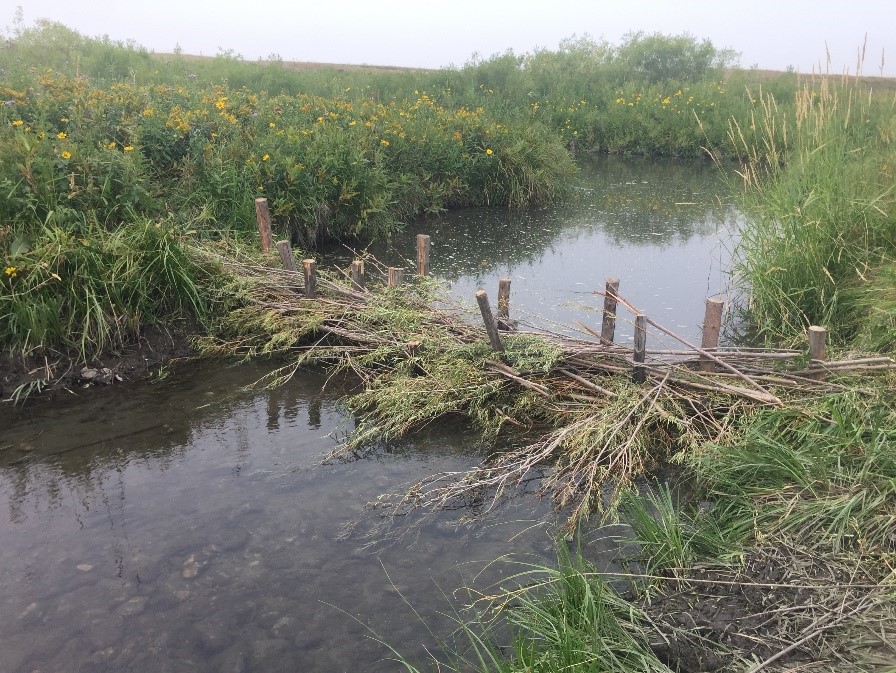
Beaver mimicry is a cheap, easy, and effective restoration technique. (Photo by Jacob LeVitus)
Wetland restoration
Beaver mimicry is a restoration technique that has been gaining popularity due to its cheap, easy, and effective application. Groundwater, or water stored in aquifers, is particularly important for drought resilience due to its accessibility during drier periods such as late summer. During this pilot project, we are exploring the use of beaver mimicry as a restoration and educational activity in the Blackfeet Nation. We hope to increase natural water storage and restore riparian areas, enhancing resilience to warming temperatures, more frequent flooding, and reduced late-summer stream flows.
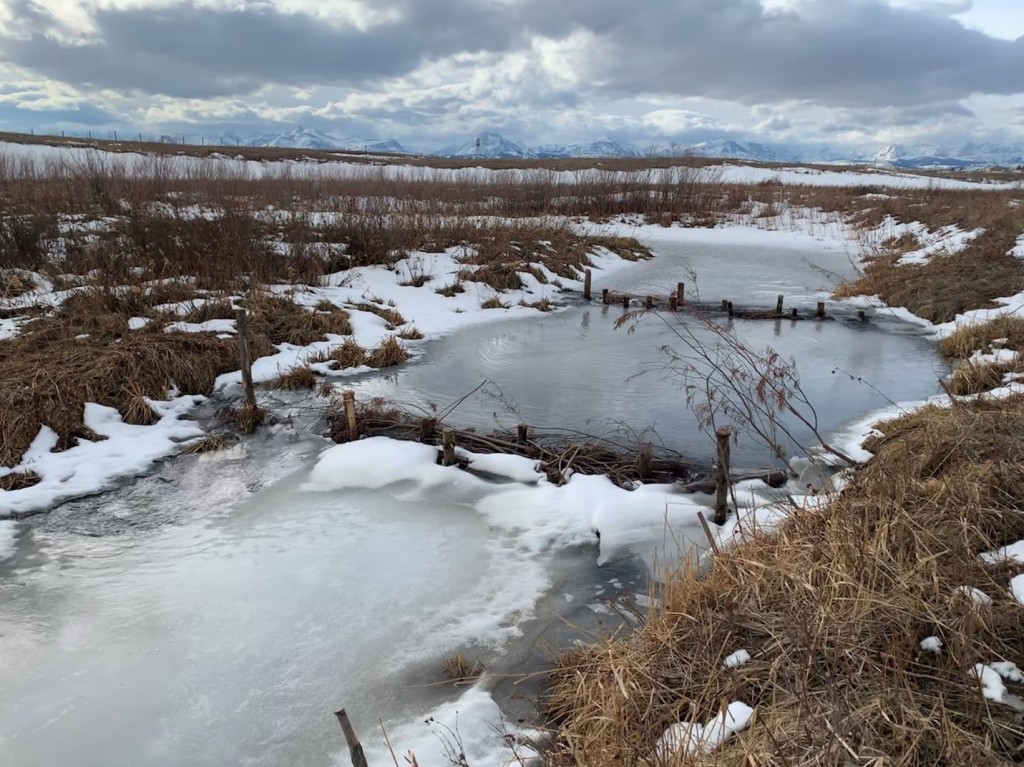
Working with beaver to naturally store water
Weather patterns are changing. Earlier snowmelt, rain-on-snow events, and increased precipitation is expected to increase flooding in late winter and early spring. Yet with climate change, we are also seeing decreasing summer stream flows. To adapt, we need to store water in places where it brings the most benefit to people and nature. Beaver dams slow down the flow of streams. They recharge groundwater and create deep ponds that provide habitat for fish and other aquatic life. Beaver dams also create floodplains that improve water quality, enhance habitat for birds, and reduce the risk of flood damage to man-made structures. A single beaver is capable of storing 10 acre-feet (ca. 3.26 million gallons) of water in its lifetime 1. Increasing natural water storage is a key way to adapt to a changing climate.
While beavers and their dams are a vital part of any wetland ecosystem, they can also create conflict, particularly in urban and residential areas. Beavers can cut down prized trees and flood roads and residential areas. During the Ksik Stakii (Beaver) Project, a pilot project, we will demonstrate and test using best beaver management practices and tools by applying non-lethal beaver management techniques, such as beaver deceivers, head gate protection, and tree fencing.
Why natural water storage?
Underground aquifers can store more water than surface water storage techniques such as and reservoirs. California’s Department of Water Resources estimated that the state’s groundwater storage capacity is between 850 million and 1.3 billion acre-feet while surface water storage is less than 50 million acre-feet in all major reservoirs 2.
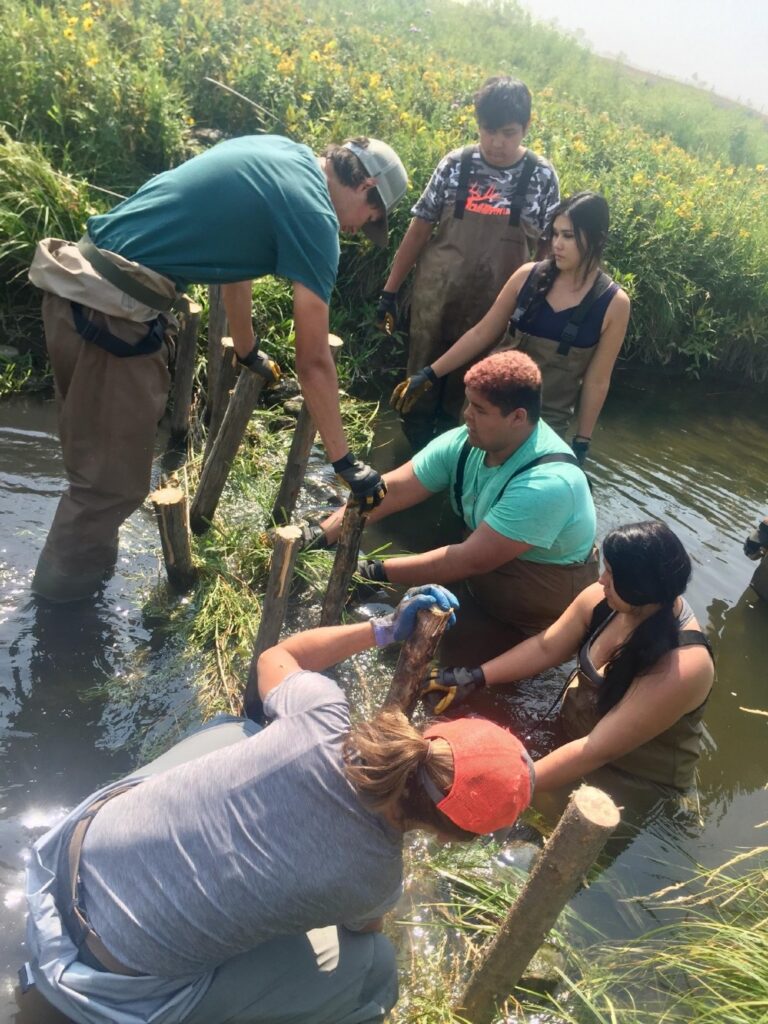
BCC Native Science Fellows building a beaver dam analogue to help increase natural water storage. (Photo by Libby Khumalo)
Beavers and beaver mimicry assist in groundwater recharge. Groundwater provides drinking water for over 97% of the rural population in the United States 3 and is relied upon for livestock, irrigation and other industrial purposes 4.
Investing in our youth
In August 2018, connections between beaver, natural water storage, and climate change preparedness (see full report here). The two-week field experience brought together 31 additional contributors from 16 departments and organizations, including Big Sky Watershed Corps, the Blackfeet Water Resources Department, Glacier National Park, Harvard University, and Yellow Bird Woman Sanctuary. To protect water in a warming, drying climate, students worked with mentors to build five, semi-permeable mimic dams (called beaver dam analogues or BDAs) in a process that mimics beaver dam-building behavior. Made of willow, sod, wood, and stones, the dams will slow water flow over time and increase natural water storage to encourage more water release in late summer when stream levels are low. The dams will also encourage aquatic plant growth on Blackfeet Community College land, where they were constructed. Students also built two partial dams. In total, the seven mimic dams will increase water storage over the Willow Creek stream reach that spans a third-of-a-mile in length.
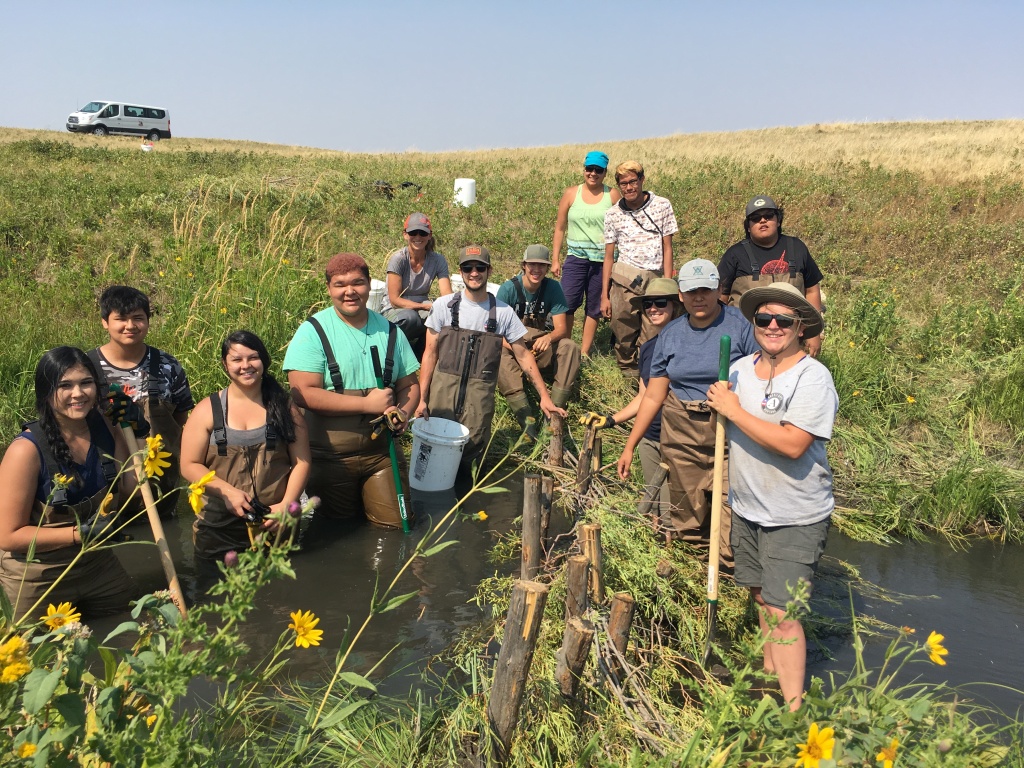
BCC Native Science Fellows, project team members, and project volunteers with the first completed beaver dam analogue. (Photo by Libby Khumalo)
In addition to building mimic dams (a process called beaver mimicry), students addressed a flooding challenge related to a beaver dam. Beaver engineer wetlands and store water by building dams, so keeping them in the landscape expands wetlands and protects against drought. At the same time, beaver can pose challenges by flooding roads and private property when they build their dams in urban areas, so keeping them in the landscape can require adaptive tools and techniques.
One such tool is called a pond leveler. Pond levelers keep beaver dams intact while lowering pond levels. Students installed a pond leveler in Willow Creek where flooding from a beaver dam was threatening private property. Installing the pond leveler has allowed the beaver family to continue living in the area while reducing the pond level.
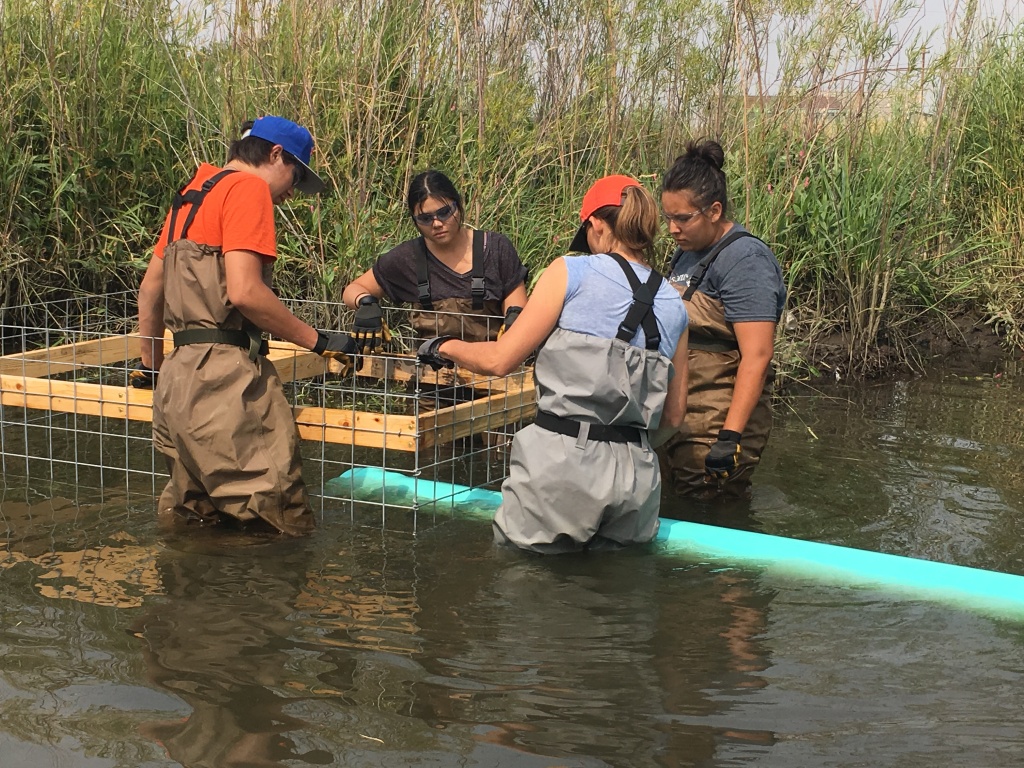
BCC Native Science Fellows install a pond leveler to manage flood risk on Willow Creek. (Photo by Libby Khumalo)
In addition to the hands-on activities of beaver mimicry and building a non-lethal beaver management tool called a pond leveler, mentors wove together presentations, visits with guest speakers, discussions, games, field trips, and group activities to augment learning over the two-week program. Speakers and mentors covered topics that included beaver ecology, the fur trade, wetlands, climate change drivers, regional climate change impacts, the Blackfeet Climate Change Adaptation Plan, adaptation opportunities, permitting requirements for stream-based activity, global and community scale mitigation strategies, climate change communication strategies, and educational and career opportunities. Students also made preliminary designs for an interpretive sign for the restoration area.
Promoting our traditional lifeways
Beavers have been an integral part of Blackfeet culture for millennia. The Ksik Stakii Project is deeply rooted in that cultural connection. During the project, there will be gatherings for youth, natural resource managers, producers, and elders to share stories and understanding about beavers and protecting our lands. This gathering will also serve as a forum to discuss the urgency and importance of climate change adaptation.
Who we are…
The Ksik Stakii Project is a partnership between Blackfeet Nation Fish and Wildlife, Blackfeet Community Collge, Blackfeet Environmental Office, the Blackfeet Agriculture Resource Management Planning Team, and the Center for Large Landscape Conservation. Support for this initiative is provided by the Wildlife Conservation Society and the Doris Duke Charitable Foundation, the Montana Department of Natural Resources and Conservation, Big Sky Watershed AmeriCorps, the Clif Bar Family Foundation, the Indian Nations Conservation Alliance, the Temper of the Times Foundation, and the Blackfeet Water Resources Department.
For more information, “like” us on Facebook!
Next, learn about our project to decrease animal-vehicle collisions through wildlife crossings.
Or, learn about:
- How other indigenous communities are adapting to climate change.
- How we are adapting to climate change in the agricultural sector.
- How we are protecting our cultural resources and traditions through climate change adaptation.
- Fish sector in the Blackfeet Climate Change Adaptation Plan.
- How we adapting to protect our waters.
Sources:
- Slabe, Tom. “Water Storage and the American Beaver, Castor Canadensis – A Solution to Colorado’s Aquatic Resources Challenges.” Sierra Club, 15 Jan. 2016, http://www.sierraclub.org/rocky-mountain-chapter/water-storage-and-american-beaver-castor-canadensis-solution-colorado-s.
- Rohde, Melissa. “Recharge: Groundwater’s Second Act.” Water In The West, Stanford University, 31 July 2014, waterinthewest.stanford.edu/groundwater/recharge/.
- Perlman, Howard. “Drought and Overpumping and Groundwater Decline.” USGS Water Science School, U.S. Geological Survey, 9 Dec. 2016, water.usgs.gov/edu/droughtandgw.html.
- Perlman, Howard. “Total Water Use in the United States, 2010.” , USGS Water Science School, U.S. Geological Survey, 4 Dec. 2017, https://water.usgs.gov/edu/wateruse-total.html.